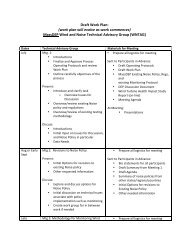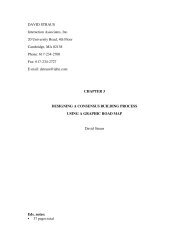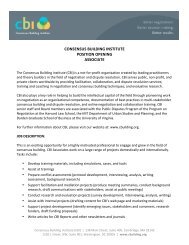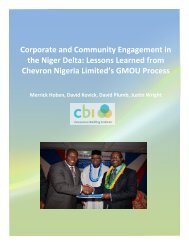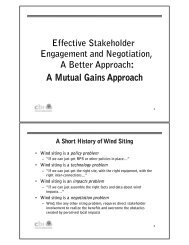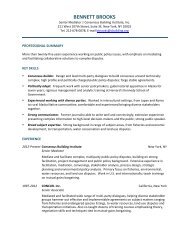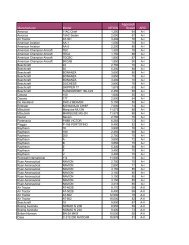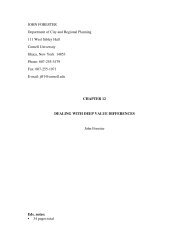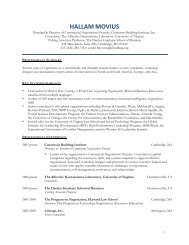Adirondack Wind Energy Park, Warren County, NY - Consensus ...
Adirondack Wind Energy Park, Warren County, NY - Consensus ...
Adirondack Wind Energy Park, Warren County, NY - Consensus ...
Create successful ePaper yourself
Turn your PDF publications into a flip-book with our unique Google optimized e-Paper software.
1 <br />
<strong>Adirondack</strong> <strong>Wind</strong> <strong>Energy</strong> <strong>Park</strong> <br />
<strong>Warren</strong> <strong>County</strong>, <strong>NY</strong> <br />
I. Location and Project Overview <br />
<strong>Adirondack</strong> <strong>Wind</strong> Partners, LLC have proposed putting a wind project, called the <strong>Adirondack</strong> <strong>Wind</strong> <br />
<strong>Energy</strong> Project, in <strong>Warren</strong> <strong>County</strong>, New York. The wind energy facility would be located in the town of <br />
Johnsburg, i on private land adjacent to a state-‐owned and operated ski facility, Gore Mountain. ii The <br />
proposed site is located within the <strong>Adirondack</strong> <strong>Park</strong>, about 80 miles north of Albany. The <strong>Adirondack</strong> <br />
<strong>Park</strong> is “the largest publicly protected area in the contiguous United States, greater in size than <br />
Yellowstone, Everglades, Glacier, and Grand Canyon National <strong>Park</strong> combined. The boundary of the <strong>Park</strong> <br />
encompasses approximately 6 million acres, nearly half of which belongs to all of the people of New <br />
York State and is constitutionally protected to remain “forever wild” forest preserve.” iii The remaining <br />
half of the <strong>Adirondack</strong> <strong>Park</strong> is owned privately. All development in the park is under the jurisdiction of <br />
the <strong>Adirondack</strong> <strong>Park</strong> Agency. <br />
The company has proposed putting a maximum of 10 turbines on a 1700 acre site iv of privately owned <br />
land within the park. The project would generate up to 30 megawatts of power, and has the potential <br />
to supply around 14,000 homes in <strong>Warren</strong> <strong>County</strong> with electricity. v The height of each of the proposed <br />
turbines for the wind project is approximately 279 feet. vi The current status of the project is that is <br />
purportedly in progress with opposition, vii but there has been little recent activity on the part of the <br />
developers. The last documented action on their part was in March 2010, when they requested <br />
extension of a permit. According to James McAndrew, Vice President of Strategic Projects at Barton <br />
Mines, the “project is paused pending a return of energy prices to pre-‐recession levels or an increase in <br />
incentives” (email). <br />
II.<br />
Demographics <br />
Map of <strong>Warren</strong> <strong>County</strong> viii
2 <br />
The <strong>Adirondack</strong> <strong>Park</strong> supports a year-‐round population of about 130,000 people; there are also a <br />
number of seasonal residents. ix “The <strong>Adirondack</strong> <strong>Park</strong> is the largest park in the contiguous United States. <br />
It contains six million acres, covers one-‐fifth of New York State and is equal in size to neighboring <br />
Vermont. The <strong>Adirondack</strong> <strong>Park</strong> is nearly three times the size of Yellowstone National <strong>Park</strong>. The <strong>Park</strong> is <br />
home for 130,000 permanent and 110,000 seasonal residents, and hosts ten million visitors yearly.” x<br />
Approximately half of the year-‐round population of the <strong>Adirondack</strong> <strong>Park</strong> resides in <strong>Warren</strong> <strong>County</strong> which <br />
has a population around 66,000 people, the majority of whom live in southern <strong>Warren</strong> <strong>County</strong>. The <br />
northern part of <strong>Warren</strong> <strong>County</strong>, like most of the <strong>Adirondack</strong> <strong>Park</strong>, is sparsely populated. <br />
The demographics of <strong>Warren</strong> <strong>County</strong> are: 23 percent of population has bachelor’s degree or higher, <br />
there are about 38,000 housing units as of 2009, and 19.2 percent of these housing units are in multi-unit<br />
structures. The median household income as of 2000 is 48,376, the percent of persons below <br />
poverty level is about 10.5 as of 2008, and the land area is 869 square miles with an average density of <br />
72.8 people per square mile. xi<br />
III.<br />
Project Background <br />
a. Who <br />
<strong>Adirondack</strong> <strong>Wind</strong> Partners LLC (AWP) was established in 2004 as a joint venture between the Barton <br />
Group and Reunion Power LLC; it was created for the sole purpose of developing the <strong>Adirondack</strong> <strong>Wind</strong> <br />
<strong>Energy</strong> <strong>Park</strong>. The Barton Group (Barton) is the parent company of Barton Mines Company, LLC, Virginia <br />
Abrasives Corporation, and Barton International Incorporated. Currently, Barton employs an estimated <br />
90 people in <strong>Warren</strong> <strong>County</strong> for its operations in North Creek and Lake George. Reunion Power LLC <br />
“specializes in the planning, development, and management of wind energy projects and provides <br />
professional services for owners and financiers of power projects.” Reunion has offices in Vermont and <br />
New Jersey. It appears to be a privately held company specializing in financial arrangements. Of the five <br />
executives listed on their website, three hold MBAs, one holds a BS, and the other holds a BFA. xii<br />
According to Reunion Power’s portfolio, they are participating in the development of four wind farms, <br />
including the <strong>Adirondack</strong> <strong>Wind</strong> <strong>Energy</strong> <strong>Park</strong>. There was little information available on the status of two <br />
of the other three projects on the internet; it appears all four Reunion wind projects are still in the early <br />
stages. xiii Bernard Melewski, an attorney and former employee of the <strong>Adirondack</strong> Council, a not-‐for-profit<br />
environmental group whose mission is to preserve the <strong>Adirondack</strong> <strong>Park</strong> xiv , provides legal <br />
representation for AWP. xv<br />
b. Why this site <br />
The site proposed for the wind facility used to be a garnet mine. The site and the mine are owned by <br />
Barton Mines Co., “a five-‐generation family business that has mined garnets for industrial use since <br />
1878.” xvi According to AWP, the site is a good choice for the turbines for the following reasons. First, in <br />
general the <strong>Adirondack</strong>s are thought to have good potential for wind generation, xvii and the AWP’s <br />
studies have shown that this site has an “excellent” wind resource. Second, the proposed site was <br />
already an industrially zoned area within the <strong>Adirondack</strong> <strong>Park</strong>, and is located next to the Gore Mountain <br />
ski area, “which is an extensively developed property according to the AWP’s website” xviii However, it is <br />
important to mention that being “extensively developed” is subjective. Gore Mountain is a large ski
3 <br />
mountain, but unlike other ski areas, it is not a resort. Its access road is not lined with restaurants, <br />
lodges, or stores. There are no buildings on the access road; it is all forested with the exception of the <br />
parking areas. <br />
The AWP has also stated that the area is easily accessible due to pre-‐existing road networks and <br />
transmission lines. xix According to the development company, minimal land alterations would be <br />
needed to construct the wind project. However, others have argued that trying to put in extremely large <br />
turbines at set locations in a 1700 acre site in the <strong>Adirondack</strong>s would require more than minimal <br />
changes. According to an overview of wind energy technology by Global <strong>Energy</strong> Concepts, “Access roads <br />
to each turbine location are typically 18 to 20 ft wide and consist of compacted crushed rock. In hilly of <br />
complex terrain, access roads are constructed to specified slopes and turning radii that are necessary to <br />
allow delivery of large components such as blades and tower sections. During the construction phase of <br />
a project, ‘crane pads’ are installed along the access road.” xx<br />
View from Gore Mountain xxi<br />
c. Financing <br />
The project is still in its early stages. However, project cost is estimated to be about 40 million dollars <br />
(email from McAndrew). “Capital costs for the construction and long-‐term ownership of the Project <br />
would be funded from a variety of sources, including Partnership equity, institutional or commercial <br />
debt, and other investor tax and yield oriented equity sources.” xxii In regards to tax credits, according to <br />
James McAndrew, “the federal PTC and New York State RPS are both necessary for financing and to <br />
make the project economics work.” Last, when asked how many turbines are needed to break even on
4 <br />
the project, McAndrew responded that the site only has room for ten or eleven turbines, which is <br />
enough. <br />
d. Electricity in New York State <br />
New York has one of the highest average electricity rates in the United States. xxiii According to <br />
McAndrew, the projected cost of electricity from the wind facility would be “level” at various points in <br />
the future, but he will not know exactly what the price will be until the AWP buys equipment. <br />
McAndrew also noted that, “the power from this project would not be directly available to the <br />
community, but sold into the <strong>NY</strong> Wholesale Grid.” <br />
In New York State, the Public Service Commission (PSC) regulates most electric utilities. “The <br />
Department of Public Service has a broad mandate to ensure that all New Yorkers have access to reliable and <br />
low-‐cost utility services. The Department is the staff arm of the Public Service Commission. The Commission <br />
regulates the state's electric, gas, steam, telecommunications, and water utilities.” xxiv<br />
National Grid is the utility that services <strong>Warren</strong> <strong>County</strong>. xxv In regard to end-‐user (residential and <br />
business), according to National Grid, prices for electricity vary depending upon a number of factors, and <br />
fluctuate on a monthly basis by load zone and wholesale cost. The constant is that the price cannot <br />
exceed the maximum rate structure set by the Public Service Commission. Johnsburg is located in the <br />
Capital load zone; xxvi the current price listed on the website is about .08 per kilowatt hour. xxvii In addition <br />
to the supply cost, there are also delivery charges and fees. However, the price referenced above is only <br />
accurate if the supply is purchased from National Grid; there are numerous other choices of suppliers, <br />
so the price can vary significantly. The cost of obtaining a higher percentage of one’s energy from green <br />
power sources, according to PSC, is on average .5 to 2.5 cents higher per kilowatt hour. xxviii In summary, <br />
the current cost for electricity in Johnsburg, based on today's costs, is somewhere between 14 and 16 <br />
per kilowatt hour, depending on the variables one chooses, and assuming no additional cost for green <br />
power. <br />
IV.<br />
Controversy <br />
The choice to site this project inside the <strong>Adirondack</strong> <strong>Park</strong> is the largest point of contention, but there <br />
are also concerns about the turbines’ potential effects on wildlife, especially on birds and bats <br />
(McGrath). Though the project is supported by a number of local politicians and residents, there has <br />
been a great deal of dissent. Local environmental groups, and many local residents and vacationers to <br />
the <strong>Adirondack</strong>s have protested the idea of putting a wind farm in the <strong>Park</strong>. At this time, noise does not <br />
appear to be considered to be as much of an issue as aesthetic concerns. <br />
a. Who is For <strong>Wind</strong> Project and Why <br />
On the state level, New York is officially supportive of renewable energy. According to the Cornell <br />
University New York State <strong>Wind</strong> Study Final Report, the state is facing economic, environmental, and <br />
political pressure to develop sources of renewable, clean energy. Some of those pressures include the <br />
fact that New York’s overall electricity demand is expected to rise in the next decade by as much as 20%, <br />
and energy prices in the state are already relatively expensive. Furthermore, New York’s renewable <br />
energy portfolio standards (RPS), also known as renewable energy purchase mandates, are helping to <br />
drive the demand for renewable energy resources in general, and wind energy in particular. “The
5 <br />
current New York State RPS calls for an increase in renewable energy used in the state from the current <br />
level of about 19% to 25% by the year 2013.” xxix<br />
Those who have publicly endorsed this project include the <strong>Warren</strong> <strong>County</strong> Conservative Party, the <br />
<strong>Warren</strong> <strong>County</strong> Democratic Party, the <strong>Warren</strong> <strong>County</strong> Independence Party, the <strong>Warren</strong> <strong>County</strong> <br />
Republican Party, Democracy for the Greater Glens Falls Area, <strong>Warren</strong> <strong>County</strong> Board of Supervisors, <br />
town of Johnsburg, the Supervisor of the Town of Johnsburg, the Town of Chester, the Town of <br />
Thurman, the Town of Stony Creek, the Town of Lake Luzerne, the Town of Queensbury, the Town of <br />
Lake George, the Town of Hague, the Town of Horicon, the Town of <strong>Warren</strong>sburg, Gore Mountain <br />
Chamber of Commerce, the <strong>Warren</strong> <strong>County</strong> Soil and Water Conservation, the <strong>Warren</strong> <strong>County</strong> Economic <br />
Development Corporation, Gore Mountain, Front Street Mountain development, Essex <strong>County</strong> Board <br />
Supervisors, the Town of Schroon, the Town of Minerva, the Hamilton <strong>County</strong> Board of Supervisors, the <br />
Town of Long Lake, the Town of Indian Lake, the Town of Wells, the Town of Inlet, the Washington <br />
<strong>County</strong> Board of Supervisors, the Town of Putnam, the <strong>Adirondack</strong> <strong>Park</strong> Local Government review Board, <br />
the Business Council of New York State, the <strong>Adirondack</strong> Association of Towns and Villages, and the Town <br />
of Newcomb. xxx As seen by this extensive list, a number of local community governments have been <br />
supportive of the wind project. Greenpeace and Kirsten Gillibrand, xxxi a United States Senator for New <br />
York, have also indicated their support for the project. xxxii<br />
Supporters of the wind project state several reasons for their endorsements. First, their main point is <br />
that the project is promoting the use of green, renewable energy. They claim that the wind project’s <br />
environmental contribution will be equal to taking 11,000 cars off of the road. Using more renewable <br />
energy helps to reduce acid rain, improve air quality, and curb greenhouse gas emissions. Acid rain is a <br />
huge issue in northern New York – the <strong>Adirondack</strong> <strong>Park</strong> has been adversely affected by acid rain. xxxiii<br />
AWP has also said that the project is expected to produce significant tax revenue, and help New York <br />
State meet its renewable energy goals (About). The project will create jobs in the local community; AWP <br />
has said it could employ about 75 construction workers for six to ten months. In addition, running the <br />
wind facility would require two to three permanent full time project technicians. xxxiv The AWP holds that <br />
aesthetic concerns are largely unfounded, as the visual impact of the wind turbines is not going to <br />
present a significant problem. The turbines’ siting is in the context of the Gore Mountain Ski Resort, and <br />
Barton has also said that the wind turbines “would barely be visible from surrounding roads and hiking <br />
areas. The <strong>Adirondack</strong> Council vehemently disputes this” (McGrath) <br />
Furthermore, AWP claims that, “the current transmission will be affected in two positive ways. First, <br />
generation imported to the project region from outside the park will be reduced on a direct basis from <br />
the wind farm. The composition of the net generation substituted for the imported generation will be <br />
100% green renewable energy generated by the wind farm. Second, in general terms, power generated <br />
closest to the local load is more reliable and sustains fewer transmission losses. From a system <br />
performance standpoint, the power is more efficient and stable.” xxxv However, this statement from <br />
AWP, which indicates their intent to use the electricity locally, is contradicted by McAndrew’s more <br />
recent statement that the power would be sold to the wholesale grid. <br />
b. Who is Against <strong>Wind</strong> Project and Why <br />
A number of local residents and environmental groups, and lovers of the <strong>Adirondack</strong> <strong>Park</strong> in general, <br />
have come out against the wind turbines. Judging by posts on the <strong>Adirondack</strong> Museum’s questionnaire <br />
about the proposed project, there is a significant percentage of people against the wind farm; it is a very <br />
divisive issue. “Two <strong>Adirondack</strong>-‐based environmental groups have come out against the installation of <br />
windmills atop Gore Mountain. The Association for the Protection of the <strong>Adirondack</strong>s and the
6 <br />
<strong>Adirondack</strong> Council say their reasons for opposing the windmills range from aesthetic concerns to <br />
setting a poor precedent.” xxxvi<br />
These groups have expressed a number of concerns about the project. First, the <strong>Adirondack</strong> <strong>Park</strong> and <br />
its scenic views are beloved by many people. “The wind turbines will be visible along an exposed ridge, <br />
compromising the wild forest character of the <strong>Adirondack</strong>s” (<strong>Adirondack</strong> Voices). A document prepared <br />
for the New York State <strong>Energy</strong> Research and Development Authority lists areas in the state that have <br />
good wind energy potential. <strong>Warren</strong> <strong>County</strong> is not on this list; it was left off because the authors <br />
assumed protected areas within the <strong>Adirondack</strong>s were exempt from wind energy development. xxxvii<br />
A number of the comments on the <strong>Adirondack</strong> Museum site mentioned the limited capabilities of <br />
wind power, including energy storage, cost, and failure to remove coal plants from the grid. Joanie <br />
Simmons of Canandaigua, <strong>NY</strong> stated that “Conventional plants need to keep running to back up variable <br />
wind output -‐ so wind is duplicating, not replacing, electricity generation.” Furthermore, this project has <br />
raised some questions about how green wind energy is. According to Simmons, “The process of <br />
manufacturing, transporting and on-‐site construction of the turbines adds to the environmental <br />
problems. The clearing of thousands of acres of trees for access roads and siting destroys a natural <br />
method of taking CO2 from the air.” Also, “John Sheehan, a spokesman for the <strong>Adirondack</strong> Council, said <br />
that if one wind energy project is admitted to the park, it will open the door to others. “In this case, the <br />
cost of developing wind power would be too high to justify on any scale except Barton/Reunion’s <br />
financial calculations. If it is approved, it won’t be the last one in the <strong>Adirondack</strong>s"’ (McGrath). <br />
There are concerns about the effect of the turbines’ rotating blades on birds, particularly Bicknell's <br />
thrush, and on bats, whose numbers are already dwindling due to a fungal disease. xxxviii “It may not be <br />
wilderness, but bird lovers say the Barton mountaintop could well be a nesting place for the Bicknell’s <br />
thrush” (McGrath). Bicknell’s thrush is a songbird that lives in the high altitudes of the <strong>Adirondack</strong>s and <br />
has been given a “special concern” status by New York State xxxix due to its limited range and relatively <br />
small population. xl In regards to the bats, “according to the Christian Science Monitor, bat populations <br />
in the Northeast have declined an average of 73 percent each year since the discovery of the fungus in a <br />
cave near Albany, N.Y.” xli This disease is known as the white-‐nose syndrome, and “infection makes bats <br />
restless during the winter, causing them to stir when they should be hibernating and to use up their fat <br />
reserves.” xlii Those advocating against the wind farm have suggested making existing systems more <br />
efficient, such as upgrading old buildings, rather than supporting and investing in the Barton Mines <br />
project. <br />
According to the <strong>Adirondack</strong> Council, “The arguments [against the wind turbines] are not a "Not In <br />
My Back Yard," or NIMBY, statements. More than half of the 6 million acre park is for the public. "It's <br />
everybody's back yard, that's what concerns us," Sheehan said. "It is not in character of the community"’ <br />
(Fiegl). Last, one of the big arguments used by AWP is that the wind facility is good for the local <br />
community. However, the power from the wind farm would not necessarily be used locally; it would be <br />
sent out to the state grid where all of the power is all pooled. xliii<br />
At this point, no lawsuit has been filed to try to stop the wind project, but the <strong>Adirondack</strong> Council has <br />
threatened to take legal action (McAndrew email). <br />
Other comments made by those against the wind farm included on the <strong>Adirondack</strong> Museum website <br />
were: <br />
Joanie Simmons Canandaigua, <strong>NY</strong>: “The treasure of New York’s natural beauty, once destroyed, is not <br />
renewable.” And “Industrial wind is a multi-‐billion dollar business. Why Follow the money. Tax credits, <br />
subsidies, and high rates make a profit for developers. <strong>Wind</strong> companies use this money, which comes <br />
from taxpayers and consumers, to influence our politicians. Then they sell carbon offsets to polluters. <br />
How does this help the environment”
7 <br />
John Droz, jr. Brantingham Lake, <strong>NY</strong>: “Many of the comments here appear to be from good, well-intentioned<br />
people who have been duped by the industrial wind profiteers’ aggressive Madison Avenue <br />
campaign.” <br />
V. Where the Project is Now <br />
In general, there are six steps in the lifecycle of a wind energy project – wind resource assessment <br />
and site selection, permitting, financing, construction, operation decommissioning. At this point, the <br />
project appears to be on the first step. In 2010, the <strong>Adirondack</strong> <strong>Park</strong> Agency renewed AWP’s permit for <br />
the second time for a 50-‐meter wind monitoring tower, xliv called a MET Tower, to record wind speed, <br />
direction, and temperature at the proposed site. According to McAndrew, the MET Tower was first <br />
installed in the fall of 2003, and began collecting data at that time. “A second monitoring tower had <br />
been located on the site but was "felled by ice" and removed. The 50-‐meter tower is only visible from <br />
an area called the Vly in the Siamese Ponds Wilderness Area, APA planner Leigh Walrath told the <br />
committee. The renewed permit allows the company to continue collecting wind data for another two <br />
years to fine tune its commercial wind farm proposal. The company initially planned to submit a permit <br />
for the wind farm in early 2009, but the economic downturn and a drop in electricity prices combined to <br />
put the development on hold, according to the draft permit for the monitoring tower. <strong>Adirondack</strong> <strong>Wind</strong> <br />
Partners has advised agency staff that it plans to submit an application for a commercial wind farm <br />
within the next two years," the permit says.” xlv<br />
If, and when, the permitting process takes place, the wind project will be subject to APA regulations, <br />
which are stringent. <br />
“Planning for development within the <strong>Adirondack</strong> <strong>Park</strong> combines the cooperation of local <br />
governments and the <strong>Adirondack</strong> <strong>Park</strong> Agency (APA). Although local government focuses on local <br />
development, the APA oversees development that affects the entire <strong>Park</strong>. The New York State <br />
Legislature created the APA in 1971 for the purpose of developing a long-‐range master plan for <br />
management of State lands and for the preparation of a land use and development plan for private <br />
lands within the <strong>Adirondack</strong> <strong>Park</strong>. The <strong>Adirondack</strong> <strong>Park</strong> Agency Act, along with the Rules and <br />
Regulations and the <strong>Adirondack</strong> <strong>Park</strong> State Land Master Plan were written to protect the public and <br />
private resources of the <strong>Park</strong>. The permitting process will require the APA to act as lead agency to <br />
<strong>Adirondack</strong> <strong>Wind</strong> <strong>Energy</strong> <strong>Park</strong> and the Project will be required to adhere to all permitting <br />
requirements.” xlvi<br />
“The <strong>Adirondack</strong> <strong>Park</strong> Land Use and Development Plan applies to both public and private lands <br />
within the park. The Plan is designed to conserve the <strong>Park</strong>’s natural resources and open-‐space character <br />
by directing and clustering development so as to minimize its impact on the <strong>Park</strong>. Under the Plan, all <br />
private lands are mapped into six land use classifications: hamlet, moderate intensity use, low intensity <br />
use, rural use, resource management, and industrial use. Guidelines are specified for the intensity of <br />
development within each category, based on number of buildings per square mile. Projects of regional <br />
significance usually require a permit from the <strong>Adirondack</strong> <strong>Park</strong> Agency” (More). <br />
Noise levels are another consideration. “The State of New York does not have regulations that set <br />
community noise exposure criteria. The New York State Department of Environmental Conservation <br />
Regulations 6<strong>NY</strong>CRR implements the provisions of the State Environmental Quality Review Act (SEQR). <br />
These regulations have established policy and guidance for comprehensive environmental impact <br />
assessment. These regulations do not include specific noise impact criteria but constitute guidance on <br />
impact assessment procedures. Individual communities can also establish noise regulations through
8 <br />
community by-‐laws and some local communities have additional noise regulations.” xlvii Johnsburg <br />
zoning law does set noise standards that apply to all uses requiring Site Plan Approval. These standards <br />
include noise level limits. “Sound levels exceeding 55 dBA between the hours of 7 AM and 11 PM, or <br />
exceeding 45 dBA between the hours of 11 PM and 7 AM, as measured at the property line, shall be <br />
avoided.” However, the introduction to the land use document states that “nothing in this Local Law <br />
shall be deemed to supersede….the jurisdiction of the <strong>Adirondack</strong> <strong>Park</strong> Agency.” xlviii<br />
According to the <strong>Adirondack</strong> <strong>Wind</strong> <strong>Energy</strong> Project website, “The permitting process for <strong>Adirondack</strong> <br />
<strong>Wind</strong> <strong>Energy</strong> <strong>Park</strong> will be extensive and will require <strong>Adirondack</strong> <strong>Wind</strong> Partners to perform impact <br />
analysis. The studies will include visual, flora, fauna, bird, bat, soil erosion, and geological surveys.” As <br />
of February 2009, some of these studies have already been completed, according to McAndrew. “The <br />
bird and bat study is complete. Visual Impact, Logistics/Transportation and Historical/Archeological <br />
studies are partially done” (McAndrew email). The purpose of the bird and bat study was to determine <br />
whether migration patterns exist in the area at the height of the wind turbines. This study’s results have <br />
indicated that the wind turbines should not pose a threat to migrating birds. The micrositing of the <br />
turbines has also been completed. However, there appears to be a significant amount of work to be <br />
done before the AWP submits its application and seeks approval for the wind project from the APA. “An <br />
APA permit review supersedes the State Environmental Impact Review for projects in the <strong>Adirondack</strong> <br />
<strong>Park</strong>” (McAndrew email). At this point, AWP has not yet submitted their application because not all of <br />
the studies are complete. <br />
One of the biggest challenges the wind project will have to overcome is the height of the turbines, <br />
which greatly exceed heights normally allowed within the park. The <strong>Adirondack</strong> <strong>Park</strong> Agency has set <br />
stringent height regulations. In fact, APA policy seeks to ensure that towers within the park are <br />
“substantially invisible.” xlix “Under the <strong>Adirondack</strong> <strong>Park</strong> Agency Act, all new structures in excess of forty <br />
feet in height require an Agency permit as a Class A regional project. Where a structure is supported by <br />
fill, height is general measured from the highest point of the structure t the original grade beneath the <br />
structure. (In certain circumstances height is measured from the top of the structure to the bottom of <br />
the slope of the supporting fill.”) l<br />
The turbines would also be located at an elevation of over 2500 feet, making their height impact <br />
more significant. According to the Summary of <strong>Adirondack</strong> <strong>Park</strong> Authority over Land Use and <br />
Development and Subdivisions, if a location is over 2500 feet, then it appears to have automatic <br />
designation as a critical environmental area, and needs an APA permit. li Last, the proposed site for the <br />
wind project is adjacent to the Siamese Ponds Wilderness, which is an area of over 175 square miles <br />
encompassing mountains, streams, ponds, forests, and wildlife. lii<br />
More relevant information from the APA website: <br />
1. “How does the Agency decide whether to grant a permit” <br />
“Agency staff evaluates the ability of the development site or building to accommodate the proposed <br />
activity without significant environmental effects. The proposed activities, site development features, <br />
character of the area, and other factors will be used to determine if the project is appropriate as <br />
proposed or if the proposal will need to be modified. The Agency is required to determine whether a
9 <br />
project will result in “undue” environmental impacts taking into account the project’s potential <br />
economic and other benefits.” <br />
2. “What other permits may be required” <br />
“The <strong>Adirondack</strong> <strong>Park</strong> Agency is not the only regulatory agency with responsibilities in the <strong>Adirondack</strong> <br />
<strong>Park</strong>. Many local governments have zoning and subdivision requirements which should be investigated. <br />
In addition, air and water discharge, solid waste disposal and other permits may be required from the <br />
New York State Department of Environmental Conservation and sanitary or other permits may be <br />
required from the State Department of Health.” liii<br />
VI.<br />
Responses <br />
a. The Times Union <br />
The Times Union is a local newspaper serving New York’s capital region. It had a number of articles <br />
about the <strong>Adirondack</strong> <strong>Wind</strong> <strong>Energy</strong> Project. The vast majority of articles pertaining to the wind project <br />
were published in 2005 and 2006. There were several news articles covering the wind project at <br />
various times when new information developed. There were also a number of editorials both for and <br />
against the wind project. <br />
Opinion columns in favor of the wind project were written by people associated with the AWP, and <br />
by some local residents. These columns promoted the project largely because of its encouragement of <br />
green energy. These articles cited acid rain and global warming, and some supported the AWP’s belief <br />
that the proposed site is a good location for a wind farm. Some stated that this project would show <br />
that New York is serious about its renewable energy initiative, and disparaged using “not in my <br />
backyard” arguments. There was also the idea that the area could turn into an ecotourism destination if <br />
the wind project were to be successful. Last, several articles, both for and against the wind project, <br />
cited former Governor Pataki’s support of renewable energy initiatives. <br />
According to one of the editorials that was written in response to another column against the wind <br />
farm, <br />
“Lastly, it is disappointing that LeBrun disregards the larger context in which AWEP has been <br />
proposed. Ignored are serious environmental concerns about acid rain, mercury in our lakes and the <br />
looming effects of global warming. Overlooked is our national addiction to fossil fuels and the <br />
enormous cost of securing and protecting its overseas sources. The wind turbines of AWEP will not <br />
"trump the natural world around them," as LeBrun writes, in fact they will help preserve it.” liv<br />
There were also a number of articles against the wind project written by people associated with the <br />
<strong>Adirondack</strong> Council, the Association for the Protection of the <strong>Adirondack</strong>s, Fred LeBrun (a columnist for <br />
the Times Union), <strong>NY</strong>SERDA president Peter Smith and local area residents. They expressed their beliefs <br />
that the United States needs to use greener sources of energy, but not at the expense of the <strong>Park</strong> and <br />
wilderness preservation.
10 <br />
According to one of the editorials, <br />
“Visibility is no small matter in the <strong>Adirondack</strong>s. More than 10 million people a year come here to <br />
enjoy the unspoiled vistas and wild beauty so lacking back home. As every other corner of the <br />
Northeast is cluttered with ridgeline development and towers, the <strong>Adirondack</strong>s remain an ocean of <br />
green, where nearly all development is concealed beneath the treetops. Ironically, we could save <br />
more than 30 megawatts of power in the <strong>Adirondack</strong> <strong>Park</strong> through simple, proven conservation <br />
methods in homes and businesses. “<strong>Wind</strong> power has environmental consequences, too. If the <br />
Barton project goes forward, construction noise will affect the adjacent Siamese Ponds <br />
Wilderness. Muddy runoff will flow into local streams. And 10 acres or more of a forested <br />
mountaintop will be permanently denuded, and filled with steel and concrete. Bird and bat <br />
deaths are fewer with newer turbines, but are still a problem.” lv – John Sheehan <br />
Some other examples of articles from the Times Union: <br />
1. Bureaucracy Holds Back <strong>Wind</strong> Power<br />
http://albarchive.merlinone.net/mweb/wmsql.wm.requestoneimage&imageid=8080440 <br />
2. Infrastructure exists for wind power project <br />
http://albarchive.merlinone.net/mweb/wmsql.wm.requestoneimage&imageid=6418617 <br />
3. LeBrun missed an opportunity to promote benefits of wind energy park <br />
http://albarchive.merlinone.net/mweb/wmsql.wm.requestoneimage&imageid=6415677 <br />
4. LeBrun right about bad impact of wind turbines. <br />
http://albarchive.merlinone.net/mweb/wmsql.wm.requestoneimage&imageid=6415676 <br />
5. This <strong>Wind</strong> Blows Ill for Wilderness <br />
http://albarchive.merlinone.net/mweb/wmsql.wm.requestoneimage&imageid=6415049 <br />
6. Opposition to building wind turbines dismaying <br />
http://albarchive.merlinone.net/mweb/wmsql.wm.requestoneimage&imageid=6414290 <br />
7. <strong>Wind</strong> turbines plan sweeping forward <br />
http://albarchive.merlinone.net/mweb/wmsql.wm.requestoneimage&imageid=6413433 <br />
8. Other regions of New York offer more potential than <strong>Adirondack</strong>s <br />
http://albarchive.merlinone.net/mweb/wmsql.wm.requestoneimage&imageid=6377651 <br />
9. Barton Mines is Right Site for <strong>Wind</strong> Turbines <br />
http://albarchive.merlinone.net/mweb/wmsql.wm.requestoneimage&imageid=6301198 <br />
b. The PostStar <br />
The Post Star is based in Glens Falls, New York. According to their website, “they are the dominant <br />
news source in the <strong>Adirondack</strong> region of New York.” lvi Below are examples of some of the articles – <br />
They are a mixture of news reports and editorials, largely in 2005 -‐ 2008. The news articles cover the <br />
project’s progress and controversy surrounding the wind project. Many of the editorials, both for and <br />
against the park, discuss whether the benefits of the facility outweigh the costs of the choice of site, and <br />
some of the editorials also discuss the role of humans, and human action, within the <strong>Park</strong>. <br />
1. Tilting at <strong>Wind</strong>mills – written by Will Doolittle who is the projects editor at the Post Star -‐ <br />
editorial in favor of wind farm http://poststar.com/news/columns/wdoolittle/article_94879a66-‐<br />
95a0-‐52ef-‐b91c-‐26f280f8a751.html
11 <br />
2. Grabbing at Nothing but Air – written Erin DeMuth Judd – news report illustrates how difficult it <br />
is to put any towers up in <strong>Adirondack</strong> <strong>Park</strong> http://poststar.com/news/local/article_829aa432-‐<br />
4405-‐5fd7-‐81bd-‐60c729a12ae6.html <br />
3. Group Updates Turbine Plan – news report written by Bonnie Naumann -‐ The article quotes <br />
McAndrew saying that “the wind project began because he was asked by company officials to <br />
cut energy costs for the company.” http://poststar.com/news/local/article_4a67bbf4-‐5460-‐<br />
5873-‐98ce-‐bc66a2218fdc.html <br />
4. A Better Way Exists to Tackle <strong>Wind</strong> Power – written by David Gibson of the Association for the <br />
Protection of the <strong>Adirondack</strong>s against the proposed wind facility <br />
http://poststar.com/news/opinion/mailbag/article_571d6117-‐fe55-‐5a3e-‐83ed-‐<br />
9e3f9569e51a.html <br />
c. The <strong>Adirondack</strong> Daily Enterprise – “The only daily newspaper published in the <strong>Adirondack</strong> <strong>Park</strong>” <br />
After looking through the archives of the <strong>Adirondack</strong> Daily Enterprise, it appears that they have <br />
relatively few articles covering the wind project. A couple of the articles are recent. One is a letter to <br />
the editor by AWP attorney Bernard Melewski in favor of wind turbines in the park. <br />
On another note, a 2009 article discussed an APA commissioner’s desire to put wind turbines on <br />
Whiteface, another ski resort in the <strong>Adirondack</strong>s. “The idea of wind turbines on state-‐owned ski resorts <br />
in the <strong>Adirondack</strong> <strong>Park</strong> has not gained much public support, or even consideration, but state <strong>Adirondack</strong> <br />
<strong>Park</strong> Agency commissioner Art Lussi wants to change that.” lvii<br />
d. The New York Times <br />
The New York Times published at least two editorials referring to the <strong>Adirondack</strong> <strong>Wind</strong> Project: <br />
1. An editorial in the New York Times in favor of the wind project by Bill McKibben. <br />
http://query.nytimes.com/gst/fullpage.htmlres=9C02E7D6123AF935A25751C0A9639C8B63&scp=2&sq<br />
=adirondack%20wind%20energy%20park&st=cse <br />
2. An editorial in the New York Times against the wind project in response to Bill McKibben by Cheryl <br />
Long. <br />
http://query.nytimes.com/gst/fullpage.htmlres=9403E7DB1F3AF931A15751C0A9639C8B63&scp=7&sq<br />
=adirondack%20wind%20energy%20park&st=cse <br />
VII.<br />
Food for Thought <br />
a. Can the obstacles presented by the proposed siting of this wind project be overcome <br />
According to James McAndrew, Vice President of Strategic Projects at Barton Mines, if the wind project <br />
is to go ahead, the biggest obstacles that need to be overcome are:
12 <br />
“<strong>Energy</strong> prices and/or incentives must increase sufficiently to bring the projected economics <br />
back to profitable levels and a change in top level leadership at the <strong>Adirondack</strong> <strong>Park</strong> Agency is <br />
needed.” <br />
b. Questions <br />
1. Is the “green energy” argument sufficient to overrule other concerns regarding wind <br />
projects <br />
c. Other Thoughts <br />
<strong>Wind</strong> is starting to get a bad reputation in some parts of New York. The two articles referenced <br />
below illustrate concerns that wind power is more of a financial success than an environmental success. <br />
Some New Yorkers have started to associate wind farms with corruption and greed. <br />
A New York Times article titled, “In Rural New York, <strong>Wind</strong>mills Can Bring Whiff of Corruption,” <br />
discussed claims by New York residents that wind farms had torn communities apart, largely as a result <br />
of leasing arrangements with locals supposedly acquired through corruption, intimidation, and greed. <br />
New York Governor Andrew Cuomo, and former state attorney general, at one point investigated claims <br />
that wind companies had been engaging in illegal activities, including improperly influencing local <br />
officials, and that “different companies [had] colluded to divide up territory and avoid bidding against <br />
one another for the same land.” lviii<br />
An editorial originally published in The Empire Page, stated that <br />
“It becomes clear that the extreme variability of wind power makes it totally unsuitable for baseload power. <br />
On the financial front, the northern New York wind projects are yielding a very low return on their <br />
investment, averaging less than 4% before expenses, according to the Federal <strong>Energy</strong> Regulatory <br />
Commission. We have to ask, Why would a wind developer spend (roughly) $3 million per turbine in an area <br />
with winds less than the minimum recommended by <strong>NY</strong>SERDA (<strong>NY</strong>S <strong>Energy</strong> Research & Development <br />
Authority) The answer appears to be that the real goal of <strong>NY</strong> wind projects is not cheap renewable power, <br />
but the sale of tax credits and green credits. The inescapable question becomes, Is wind power just an <br />
elaborate tax break Ostensibly created to allow struggling wind companies to lower their tax burden, tax <br />
credits are sold to corporations and investors because wind company write-‐offs — particularly double <br />
declining balance depreciation — are so lucrative. Bear in mind that while <strong>NY</strong>S is cutting funds to hospitals, <br />
nursing homes and schools, it continues to subsidize wind power. Is wind power really a clean, effective <br />
means of reducing global warming While wind turbines are non-‐polluting once they are up and running, the <br />
manufacture, transport and construction of a wind turbine produces thousands of tons of carbon-‐based <br />
emissions. Every step — from mining the ore to making the steel, moving parts by ship or overland, <br />
constructing access roads, and operating giant cranes and excavators — creates emissions. Building the <br />
access roads alone produces nearly ten thousand tons of emissions. The problem of mercury pollution <br />
associated with wind projects is rarely mentioned, yet significant… Since <strong>NY</strong>S has relatively low winds (only <br />
1/50th of some western states), a wind project may never pay back its carbon debt. In many areas of <strong>NY</strong>S, <br />
hydro-‐power would have to be shut down to balance wind power suddenly gusting onto the grid. All the <br />
above is just part of the picture. <strong>Wind</strong> power has been shown to affect property value (devaluing it), create <br />
scenic blight, kill birds and bats, fragment wildlife habitat, and, not least, damage human health as revealed <br />
by recent clinical studies on <strong>Wind</strong> Turbine Syndrome. There is also the danger from turbines built too close <br />
to roads or homes, threatening ice throw (as happened recently in the UK, where people dove for cover) or <br />
blade disintegration. Another question, of course, is whether there is too much risk of unethical business
13 <br />
dealings between public officials controlling wind projects and the wind developers.” <br />
“Considering all the above — too little wind and too many people – it is small wonder that informed people <br />
are increasingly questioning whether industrial wind turbines belong in New York State.” lix -‐ Jack Sullivan <br />
Other Thoughts: <br />
1. The <strong>Adirondack</strong> <strong>Park</strong> Agency now appears to have a fast-‐track approval process for small, <br />
residential wind turbines of limited height that meet specific siting requirements. “General <br />
Permit 2009-‐2 for Installation of Certain New Small-‐Scale <strong>Wind</strong> Turbines and <strong>Wind</strong> <br />
Monitoring Masts: This general permit is issued pursuant to Section 809(13)(e) of the APA Act <br />
(Executive Law Article 27) authorizing a simplified Agency approval process for installation of <br />
one new small-‐scale wind turbine or one wind-‐monitoring mast for residential and small <br />
business use where such structures are of a design, size, location and color to blend with <br />
background vegetation, other landscape features or existing structures consistent with <br />
Section 809(10) of the APA Act and the guidance in the Agency's "Policy on Agency Review of <br />
Proposals for New Telecommunications Towers and Other Tall Structures in the <strong>Adirondack</strong> <br />
<strong>Park</strong>."’ lx<br />
2. The strength of the potential opposition to this project should not be underestimated. The <br />
APA and the <strong>Adirondack</strong> Council are formidable. There are more environmental groups that <br />
have not weighed in on this issue yet. These include the Nature Conservancy, which has been <br />
actively involved in purchasing <strong>Adirondack</strong> lands and brokering deals for preservation. lxi<br />
There are also numerous smaller environmental organizations in the area, such as Lake <br />
George Waterkeeper, the <strong>Adirondack</strong> Mountain Club, and the Darren Fresh Water Institute. <br />
i North Creek, New York. Worldnews. http://wn.com/North_Creek,_New_York <br />
ii Karlin, Rick. State Ski Center Faces Big Chill. Times Union.com. January 3, 2011. <br />
http://www.timesunion.com/default/article/State-‐ski-‐centers-‐face-‐big-‐chill-‐932184.php <br />
iii The <strong>Adirondack</strong> <strong>Park</strong>. New York State <strong>Adirondack</strong> <strong>Park</strong> Agency. 2003. <br />
http://www.apa.state.ny.us/about_park/index.html <br />
iv Audio: Interview with the Project Manager from AWEP. 2006. Radio Interview fromWENU. Audio/Video. <br />
<strong>Adirondack</strong> <strong>Wind</strong> <strong>Energy</strong> <strong>Park</strong>. http://www.adirondackwind.com/WENUinterview.htm <br />
v About. <strong>Adirondack</strong> <strong>Wind</strong> <strong>Energy</strong> <strong>Park</strong>. http://www.adirondackwind.com/about.html <br />
vi How Big is a <strong>Wind</strong> Turbine, How Much Space Do they Need Frequently Asked Questions. <strong>Adirondack</strong> <strong>Wind</strong> <br />
<strong>Energy</strong> <strong>Park</strong>. http://www.adirondackwind.com/qa.html#qa9 <br />
vii <strong>Adirondack</strong> <strong>Wind</strong> <strong>Energy</strong> <strong>Park</strong>, Gore Mountain, Barton Group. U.S. Chamber of Commerce. <br />
http://pnp.uschamber.com/2009/07/adirondack-‐wind-‐energy-‐park-‐gore-‐mountain-‐barton-‐group.html <br />
viii Welcome to <strong>Warren</strong> <strong>County</strong>, <strong>NY</strong>. <strong>Adirondack</strong>.net. http://www.adirondack.net/maps/countymaps/warren.cfm <br />
ix More About the <strong>Adirondack</strong> <strong>Park</strong>…. New York State <strong>Adirondack</strong> <strong>Park</strong> Agency. <br />
http://www.apa.state.ny.us/About_<strong>Park</strong>/more_park.html <br />
x The <strong>Adirondack</strong> <strong>Park</strong>. <strong>Adirondack</strong> Council. December 31, 2008. http://www.adirondackcouncil.org/adkpark3.html <br />
xi <strong>Warren</strong> <strong>County</strong>, New York. State and <strong>County</strong> Quickfacts. U.S. Census Bureau. <br />
http://quickfacts.census.gov/qfd/states/36/36113.html <br />
xii Reunion Team. Reunion Power. http://www.reunionpower.com/reunionteam.html <br />
xiii Development. Project Portfolio. Reunion Power. http://www.reunionpower.com/projectportfolio.html <br />
xiv Who We Are. <strong>Adirondack</strong> Council: Defending the East’s Greatest Wilderness. <br />
http://www.adirondackcouncil.org/aboutus3.html
14 <br />
xv Knight, Chris. Mine Owners Looking at Constructing <strong>Wind</strong> Farm. <strong>Adirondack</strong> Daily Enterprise. September 29, <br />
2009. http://adirondackdailyenterprise.com/page/content.detail/id/508878.html <br />
xvi McGrath, Darryl. <strong>Wind</strong> Farm Plan Rocks the <strong>Adirondack</strong>s: Division Arises Over Protecting the Scenic Views. <br />
November 27, 2005. The Boston Globe. Boston.com. <br />
http://www.boston.com/news/nation/articles/2005/11/27/wind_farm_plan_rocks_the_adirondacks/ <br />
xvii Hoerig et al. New York State <strong>Wind</strong> <strong>Energy</strong> Final Report. 2010. Cornell University. <br />
http://www.cee.cornell.edu/manage/loader.cfmcsModule=security/getfile&pageid=45619 <br />
xviii Why is this Site Better than Others Frequently Asked Questions. <br />
http://www.adirondackwind.com/qa.html#qa8 <br />
xix Site Selection. Building a <strong>Wind</strong> Farm. <strong>Adirondack</strong> <strong>Wind</strong> <strong>Energy</strong> <strong>Park</strong>. <br />
http://www.adirondackwind.com/siteselection.html <br />
xx <strong>Wind</strong> Turbines Technology. Overview. <strong>NY</strong>SERDA. Prepared by Global <strong>Energy</strong> Concepts. October 2005. <br />
http://www.powernaturally.org/programs/wind/toolkit/9_windturbinetech.pdf <br />
xxi Photo Album. More Gore. http://www.goremountain.com/multimedia/photos.cfmmode=archive <br />
xxii Where is the funding source for the expected $30 million development costs Frequently Asked Questions. <br />
<strong>Adirondack</strong> <strong>Wind</strong> <strong>Energy</strong> Farm. http://www.adirondackwind.com/qa.html#qa16 <br />
xxiii Average Retail Price of Electricity to Ultimate Customers by End-‐Use Sector, by State. Electric Power Monthly <br />
with Data for October 2010. Report Released: January 14, 2011. <br />
http://www.eia.doe.gov/cneaf/electricity/epm/table5_6_a.html <br />
xxiv About the Department of Public Service. New York State Public Service Commission. January 12, 2011. <br />
http://www.dps.state.ny.us/New_aboutdps.html <br />
xxv New York Service Territory. National Grid. <br />
http://www.nationalgridus.com/niagaramohawk/about_us/serviceterr_map.asp <br />
xxvi P.S.C. No. 220 Electricity. Superseding P.S.C. No. 207. National Grid Power Corporation d/b/a National Grid <br />
Schedule for Electric Service Applicable in All Territory Served by this Company. Initial Effective Date: September <br />
19, 2009. http://www.nationalgridus.com/niagaramohawk/non_html/rates_psc220.pdf <br />
xxvii Electric Supply Charge. National Grid. <br />
http://www.nationalgridus.com/niagaramohawk/business/rates/5_supp_charge.asp <br />
xxviii <strong>NY</strong>’s Green Power Program. Ask PSC. New York State. <br />
http://www.askpsc.com/askpsc/page/PageAction=renderPageById&PageId=a8022193f892947a1d26b675060051<br />
83#servicecompanies <br />
xxix <strong>Wind</strong> <strong>Energy</strong> in New York State: Market Drivers. New York State <strong>Wind</strong> <strong>Energy</strong> Toolkit. New York State <strong>Energy</strong> <br />
Research and Development Authority. <br />
http://www.powernaturally.org/programs/wind/<strong>Wind</strong>%20<strong>Energy</strong>%20Toolkit.pdf <br />
xxx Project Endorsements. <strong>Adirondack</strong> <strong>Wind</strong> <strong>Energy</strong> <strong>Park</strong>. http://www.adirondackwind.com/endorsements.html <br />
xxxi Thompson, Maury. Opponents Agree on Gore <strong>Wind</strong> Project. May 17, 2006. PostStar.com. <br />
http://poststar.com/highlights/campaign_trail/article_672a686f-‐8efd-‐537c-‐81df-‐4324708b7572.html <br />
xxxii Hornbeck, Leigh. Gore <strong>Wind</strong> Farm Plan Advances. Times Union.com. May 12, 2006. <br />
http://albarchive.merlinone.net/mweb/wmsql.wm.requestoneimage&imageid=6398673 <br />
xxxiii Yes or No: The Barton Group <strong>Wind</strong> Turbines. <strong>Adirondack</strong> Voices. May 15, 2008. <strong>Adirondack</strong> Museum. <br />
http://www.adkmuseum.org/discover_and_learn/adirondack_voices/question_archive/2008/yes-‐or-‐no-‐the-barton-‐group-‐wind-‐turbines/<br />
<br />
xxxiv How Many Jobs will be Created by the <strong>Adirondack</strong> <strong>Wind</strong> <strong>Energy</strong> <strong>Park</strong> Frequently Asked Questions. <br />
http://www.adirondackwind.com/qa.html#qa6 <br />
xxxv How will the Current Transmission in the <strong>Park</strong> be Affected by the <strong>Wind</strong> Development Frequently Asked <br />
Questions. <strong>Adirondack</strong> <strong>Wind</strong> <strong>Energy</strong> <strong>Park</strong>. http://www.adirondackwind.com/qa.html#qa10 <br />
xxxvi Fiegl, Charles. <strong>Adirondack</strong> Groups Oppose <strong>Wind</strong>mills. February 20, 2008. The Post Star. <br />
http://poststar.com/news/local/article_c6e1526f-‐8a5e-‐5bcc-‐9943-‐2cea7156ec1c.html <br />
xxxvii <strong>Wind</strong> <strong>Energy</strong> Development: A Guide for Local Authorities in New York. October 2002. Prepared for New York <br />
State <strong>Energy</strong> Research and Development Authority. Prepared by Global <strong>Energy</strong> Concepts, LLC. <br />
http://text.nyserda.org/programs/pdfs/windguide.pdf
15 <br />
xxxviii Nearing, Brian. Fatal Bat Disease Raging in State. November 11, 2010. Timesunion.com. <br />
http://web.timesunion.com/AspStories/story.aspnewsdate=11/11/2010&navigation=nextprior&category=REGIO<br />
N&storyID=989140 <br />
xxxix Bicknell’s Thrush Fact Sheet. New York State Department of Environmental Conservation. <br />
http://www.dec.ny.gov/animals/59558.html <br />
xl Bicknell’s Thrush. Guidance for Conservation. http://ny.audubon.org/PDFs/HRVC_BICKNELLSTHRUSH.pdf <br />
xli Jock, Francis. Fungal Disease in Brown Bats: White Nose Syndrome. Helium. <br />
http://www.helium.com/items/1959952-‐brown-‐bat-‐white-‐nose-‐syndrome<br />
xlii Gill, Victoria. Disease ‘Killed One Million Bats.’ BBC News: Science and Environment. August 5, 2010. <br />
http://www.bbc.co.uk/news/science-‐environment-‐10882769 <br />
xliii Audio: Interview with the Project Manager from AWEP. 2006. Radio Interview with the Project Manager from <br />
AWEP. http://www.adirondackwind.com/av.html <br />
xliv Agenda. New York State <strong>Adirondack</strong> <strong>Park</strong> Agency. October 14, 2010. <br />
http://www.apa.state.ny.us/Mailing/2010/10/FullAgency/October2010Agenda.pdf <br />
xlv Knight, Chris. APA Approves Jay Quarry’s Expansion. October 16, 2010. <strong>Adirondack</strong> Daily Enterprise. <br />
http://www.adirondackdailyenterprise.com/page/content.detail/id/520913.html <br />
xlvi Permitting Process. Building a <strong>Wind</strong> Farm. <strong>Adirondack</strong> <strong>Wind</strong> <strong>Energy</strong> <strong>Park</strong>. <br />
http://www.adirondackwind.com/permitting.html <br />
xlvii New York Noise Regulations. Air and Noise Compliance. http://www.airandnoise.com/<strong>NY</strong>NoiseRegs.html <br />
xlviii Town of Johnsburg Zoning Law. September 1, 2007. Adopted August 7, 2007. <br />
http://www.gratefuldesign.com/johnsburg/LLUP.pdf <br />
xlix <strong>Adirondack</strong> <strong>Park</strong> Agency Issues Over Forty Telecommunications Permits Since Revision to Towers Policy. <br />
<strong>Adirondack</strong> <strong>Park</strong> Agency. New Release. June 28, 2006. <br />
http://www.apa.state.ny.us/Press/pressrelease.cfmPressReleaseID=227 <br />
l Structure Height. New York State <strong>Adirondack</strong> <strong>Park</strong> Agency. Supplement to the Citizen’s Guide. <br />
http://www.apa.state.ny.us/documents/flyers/structure%20height.pdf <br />
li Summary of <strong>Adirondack</strong> <strong>Park</strong> Agency Authority over Land Use and Development and Subdivisions. <br />
http://www.apa.state.ny.us/Documents/Laws_Regs/HotalingTable.htm <br />
lii <strong>Adirondack</strong>s State <strong>Park</strong>. GORP Great Outdoor Recreation Pages. http://www.gorp.com/parks-‐guide/travel-‐ta-‐<br />
adirondack-‐park-‐hiking-‐adirondacks-‐sidwcmdev_065615.html <br />
liii Developing a Business in the <strong>Adirondack</strong> <strong>Park</strong>. Commonly Asked Questions. New York State <strong>Adirondack</strong> <strong>Park</strong> <br />
Agency. http://www.apa.state.ny.us/Economy/BusinessFAQs.html <br />
liv Conboy, Tim. LeBrun Missed an Opportunity to Promote benefits of <strong>Wind</strong> <strong>Energy</strong> <strong>Park</strong>. Times Union.com Archive. <br />
August 28, 2006. http://albarchive.merlinone.net/mweb/wmsql.wm.requestoneimage&imageid=6415677 <br />
lv Sheehan, John. <strong>Adirondack</strong> <strong>Park</strong> No Site for <strong>Wind</strong> Power. Timesunion.com. Archives. June 7, 2005. <br />
http://albarchive.merlinone.net/mweb/wmsql.wm.requestoneimage&imageid=6341225 <br />
lvi About Us. The Post Star. PostStar.com http://poststar.com/app/marketplace/psjobs/ <br />
lvii Lynch, Mike. Lussi Pushes for Turbines on Whiteface. PostStar.com. November 28, 2009. <br />
http://www.adirondackdailyenterprise.com/page/content.detail/id/509913/Lussi-‐pushes-‐for-‐turbines-on-‐Whiteface.html<br />
<br />
lviii Confessore, Nicholas. In Rural New York, <strong>Wind</strong>mills Can Bring Whiff of Corruption. The New York Times. August <br />
17, 2008. http://www.nytimes.com/2008/08/18/nyregion/18windmills.htmlpagewanted=1&_r=2 <br />
lix Sullivan, Jack. Industrial <strong>Wind</strong> Turbines for New York December 16, 2008. RiverCityMalone.com <br />
http://www.rivercitymalone.com/p=1396 <br />
lx APA Forms by Need. New York State <strong>Adirondack</strong> <strong>Park</strong> Agency. <br />
http://www.apa.state.ny.us/Forms/Forms_by_Need.html <br />
lxi Navarro, Mireya. 92,000 Acres Sold in the <strong>Adirondack</strong>s, With Protection Pledge. The New York Times. March 30, <br />
2009. http://www.nytimes.com/2009/03/31/science/earth/31adirondacks.html





